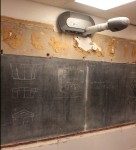 More frozen-in-time blackboards from 1917 have been found at Emerson High School in Oklahoma City. While the students were home for winter break, workers pulling old blackboards and corkboards from the wall of a classroom on the third floor discovered slate blackboards with the lessons still fresh as the day Miss Walker first chalked them for classes 7A and 7B on December 10th, 1917.
More frozen-in-time blackboards from 1917 have been found at Emerson High School in Oklahoma City. While the students were home for winter break, workers pulling old blackboards and corkboards from the wall of a classroom on the third floor discovered slate blackboards with the lessons still fresh as the day Miss Walker first chalked them for classes 7A and 7B on December 10th, 1917.
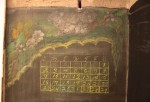 There’s a December calendar with a beautiful floral header in colored chalk, a sentence being diagrammed, studies of how to draw a three-dimensional cube, a geometry lesson with parallel lines, triangles, rectangles, a square and diamond shape. Those shapes are then deployed in a charming drawing of a cottage. While there are no colorful little girls or turkeys in this set, there is an exquisite color drawing of a home with trees covered in pink and white flowers in the foreground. It looks like something Monet would have drawn on a chalkboard.
There’s a December calendar with a beautiful floral header in colored chalk, a sentence being diagrammed, studies of how to draw a three-dimensional cube, a geometry lesson with parallel lines, triangles, rectangles, a square and diamond shape. Those shapes are then deployed in a charming drawing of a cottage. While there are no colorful little girls or turkeys in this set, there is an exquisite color drawing of a home with trees covered in pink and white flowers in the foreground. It looks like something Monet would have drawn on a chalkboard.
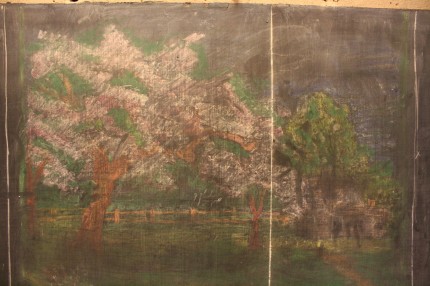
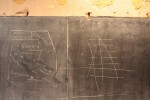 Of particular historical significance is a map of Indian Territory, modern-day eastern Oklahoma, marking the tribal boundaries and capitals. This is historically significant because the state of Oklahoma was formed by combining the Oklahoma Territory in the west with the Indian Territory in the east. While this had been Congress’ plan since the 1890 passage of the Oklahoma Organic Act, the people of the Indian Territory resisted being forced into a state with their land-grabbing neighbors to the west. As late as 1905 Indian Territory attempted to join the Union as its own state, the State of Sequoyah, but were refused. Instead President Roosevelt encouraged passage of the Oklahoma Enabling Act in 1906 which allowed delegates from both territories to come together for a state constitutional convention with a view to creating a single state. The combined Oklahoma and Indian Territories officially became the State of Oklahoma in November of 1907. That’s just 10 years before the teacher drew that map on the chalkboard. It was practically current events.
Of particular historical significance is a map of Indian Territory, modern-day eastern Oklahoma, marking the tribal boundaries and capitals. This is historically significant because the state of Oklahoma was formed by combining the Oklahoma Territory in the west with the Indian Territory in the east. While this had been Congress’ plan since the 1890 passage of the Oklahoma Organic Act, the people of the Indian Territory resisted being forced into a state with their land-grabbing neighbors to the west. As late as 1905 Indian Territory attempted to join the Union as its own state, the State of Sequoyah, but were refused. Instead President Roosevelt encouraged passage of the Oklahoma Enabling Act in 1906 which allowed delegates from both territories to come together for a state constitutional convention with a view to creating a single state. The combined Oklahoma and Indian Territories officially became the State of Oklahoma in November of 1907. That’s just 10 years before the teacher drew that map on the chalkboard. It was practically current events.
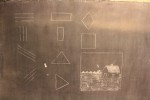 The first group of historic chalkboards was discovered last June in four classrooms on the second floor that were having their old blackboards replaced with whiteboards and smart boards. Underneath the blackboards were thin slate boards covered in math, music and handwriting lessons, hygiene tips, student names and brilliantly colored chalk drawings dated November 30th and December 4th, 1917.
The first group of historic chalkboards was discovered last June in four classrooms on the second floor that were having their old blackboards replaced with whiteboards and smart boards. Underneath the blackboards were thin slate boards covered in math, music and handwriting lessons, hygiene tips, student names and brilliantly colored chalk drawings dated November 30th and December 4th, 1917.
It seems when the old slate boards were covered with new ones over a couple of weeks in late November, early December of 1917, several teachers decided to leave their work up, dating it and signing it for posterity. The new boards were mounted on top of the old ones in wood casings with enough of a snug fit to keep the 1917 chalk from wearing away.
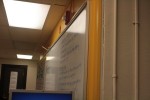 Now that they’ve been revealed, school district officials need to figure out how best to preserve them going forward. They can’t just keep them up as is because these are classrooms and wall space is a basic necessity of instruction. Besides, the chalk will fade quickly exposed to the elements (not to mention the little angels with their poor impulse control and inability to fully grasp long-term consequences). The slate boards cannot be removed and reinstalled elsewhere because the slate is so thin it would turn into a pile of debris as soon as someone started to pry it off.
Now that they’ve been revealed, school district officials need to figure out how best to preserve them going forward. They can’t just keep them up as is because these are classrooms and wall space is a basic necessity of instruction. Besides, the chalk will fade quickly exposed to the elements (not to mention the little angels with their poor impulse control and inability to fully grasp long-term consequences). The slate boards cannot be removed and reinstalled elsewhere because the slate is so thin it would turn into a pile of debris as soon as someone started to pry it off.
One of the smaller boards found last year with eight handsome red stars outlined in white has been preserved under plexiglass as a test subject. So far so good. The rest of the boards have been covered up with wood so classes can go on as normal. The covers are removable, however, and the school will uncover the chalk work for viewing on occasion. If the plexi works, perhaps the historic boards can be made visible to viewing while teachers still have space to do their daily work on top of them. I’m thinking like a sliding screen sort of jobby.